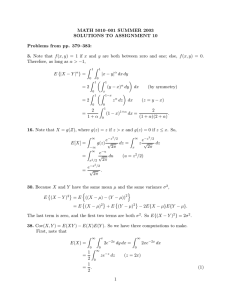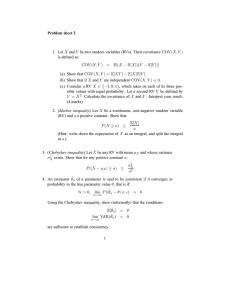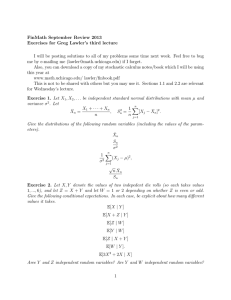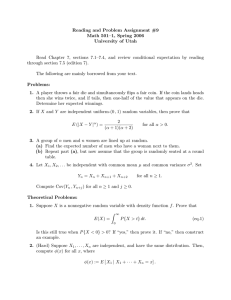Exam #2 1 Dynamic panel data models Economics 435: Quantitative Methods
advertisement
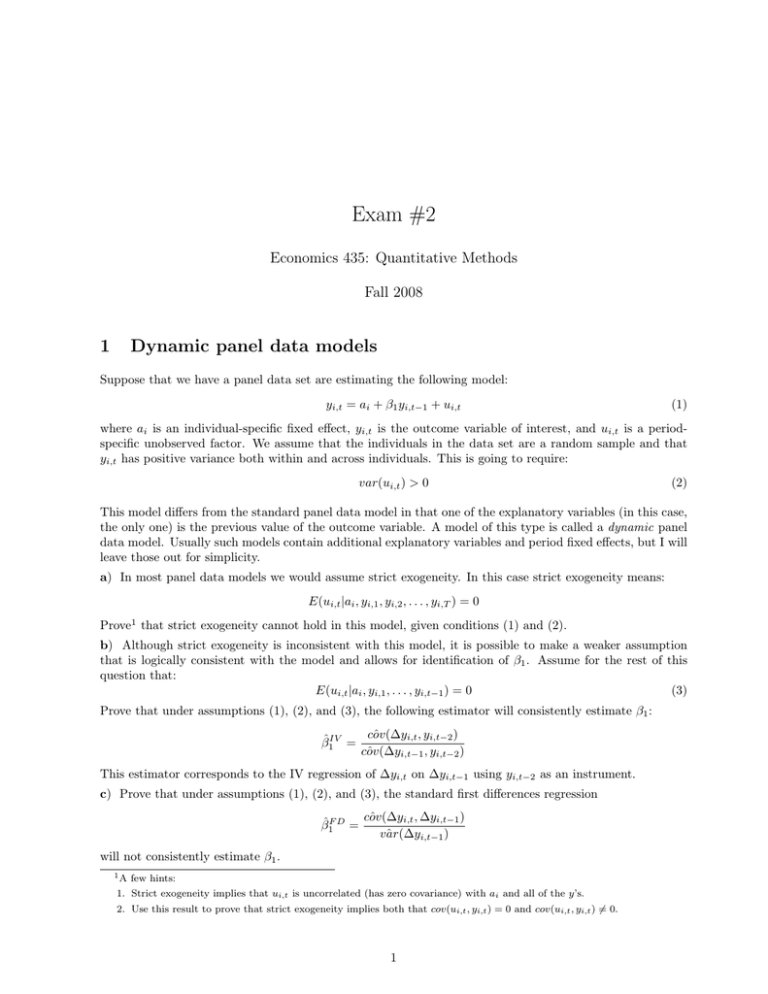
Exam #2 Economics 435: Quantitative Methods Fall 2008 1 Dynamic panel data models Suppose that we have a panel data set are estimating the following model: yi,t = ai + β1 yi,t−1 + ui,t (1) where ai is an individual-specific fixed effect, yi,t is the outcome variable of interest, and ui,t is a periodspecific unobserved factor. We assume that the individuals in the data set are a random sample and that yi,t has positive variance both within and across individuals. This is going to require: var(ui,t ) > 0 (2) This model differs from the standard panel data model in that one of the explanatory variables (in this case, the only one) is the previous value of the outcome variable. A model of this type is called a dynamic panel data model. Usually such models contain additional explanatory variables and period fixed effects, but I will leave those out for simplicity. a) In most panel data models we would assume strict exogeneity. In this case strict exogeneity means: E(ui,t |ai , yi,1 , yi,2 , . . . , yi,T ) = 0 Prove1 that strict exogeneity cannot hold in this model, given conditions (1) and (2). b) Although strict exogeneity is inconsistent with this model, it is possible to make a weaker assumption that is logically consistent with the model and allows for identification of β1 . Assume for the rest of this question that: E(ui,t |ai , yi,1 , . . . , yi,t−1 ) = 0 (3) Prove that under assumptions (1), (2), and (3), the following estimator will consistently estimate β1 : β̂1IV = cov(∆y ˆ i,t , yi,t−2 ) cov(∆y ˆ i,t−1 , yi,t−2 ) This estimator corresponds to the IV regression of ∆yi,t on ∆yi,t−1 using yi,t−2 as an instrument. c) Prove that under assumptions (1), (2), and (3), the standard first differences regression β̂1F D = cov(∆y ˆ i,t , ∆yi,t−1 ) var(∆y ˆ i,t−1 ) will not consistently estimate β1 . 1A few hints: 1. Strict exogeneity implies that ui,t is uncorrelated (has zero covariance) with ai and all of the y’s. 2. Use this result to prove that strict exogeneity implies both that cov(ui,t , yi,t ) = 0 and cov(ui,t , yi,t ) 6= 0. 1 ECON 435, Fall 2008 2 2 Instrumental variables and local average treatment effects Suppose we are using a scholarship experiment to measure the effect of university attendance on wages. We have a random sample on (y, p, z) where: zi = I(received scholarship), pi = I(attended university), and yi is subsequent wages. Let pi (z) and yi (p) be the potential outcome functions for university attendance and wages2 respectively. The scholarship is assigned by a random mechanism: Pr(zi = 1|pi (0), pi (1), yi (0), yi (1)) = Pr(zi = 1) = q The choice of whether to attend university is not random. Each individual falls into one of four categories: 1. “Always-takers” go to university whether or not they receive the scholarship, i.e., pi (0) = pi (1) = 1. 2. “Never-takers” never go to university, i.e., pi (0) = pi (1) = 0. 3. “Compliers” go to university only if they receive the scholarship, i.e., pi (0) = 0, pi (1) = 1. 4. “Defiers” go to university only if they don’t receive the scholarship pi (0) = 1, pi (1) = 0. We assume that no one is a defier, i.e., that Pr(def ier) = 0. We are interested in the treatment effect of university attendance on wages, i.e.: T Ei = yi (1) − yi (0) a) Which of the following quantities can be identified in the data? 1. E(p|z = 1) and E(p|z = 0) 2. E(y|z = 1) and E(y|z = 0). 3. E(y|p = 1) and E(y|p = 0). b) Find Pr(complier) in terms of those quantities listed in part (a) that can be identified in the data. c) Prove that E(y|z = 1) − E(y|z = 0) E(p|z = 1) − E(p|z = 0) This quantity is known as the “local average treatment effect” or LATE. E(T E|complier) = d) Is E(T E|complier) identified? e) Are E(T E|never − taker), E(T E|always − taker), or E(T E) identified? f) Prove that E(y|z = 1) − E(y|z = 0) cov(z, y) = cov(z, p) E(p|z = 1) − E(p|z = 0) g) Given the results above, prove that the IV regression coefficient: β̂ IV ≡ cov(y, ˆ z) cov(p, ˆ z) (where cov ˆ is the usual consistent estimator of the covariance) is a consistent estimator of the local average treatment effect. 2 Note that by writing the potential wage as y (p) I am assuming that the scholarship’s only effect on wages is through its i effect on attendance. This rules out, for example, the possibility that scholarship-receiving students use their improved financial position to reduce work hours and spend more time studying; or to spend more time at the pub.


